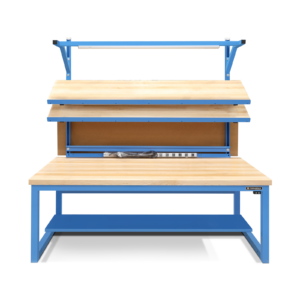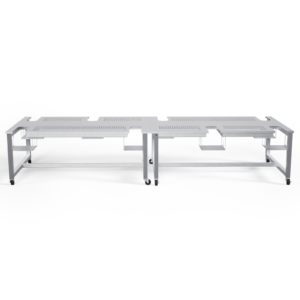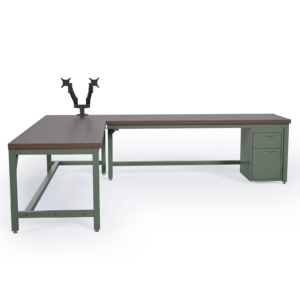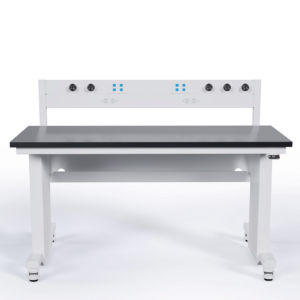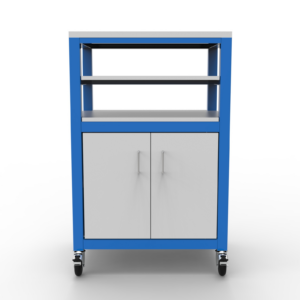In a world that’s moving faster than ever, Formaspace is using Quick Response Manufacturing (QRM) principles to reduce the lead time required to manufacture our Smart Ship™ workbenches from three weeks to just 5 business days. How is this possible? Read on to find out.
Quick Response Manufacturing: Where Lead Time Reduction is the Guiding Principle
In a world where Amazon can deliver products in a matter of hours, time has become the ultimate competitive advantage.
Customers across a wide range of industries have become increasingly time-sensitive when making purchasing decisions.
In response, savvy manufacturers in time-sensitive market sectors are working hard to optimize their production operations to achieve significant lead time reduction.
Want an example? How about the rise of print-on-demand (POD) publishers, such as Ingram, the pioneer in on-demand book publishing or VistaPrint, the online printing giant who can turn online orders for business cards and brochures around in hours? These POD publisher’s lead time reduction programs have been so effective that storing inventories of printed materials may become a thing of the past.
One of the great pioneers in this quick manufacturing revolution is Dr. Rajan Suri, who anticipated this shift decades ago when he developed the operational principles of Quick Response Manufacturing (known by the acronym QRM.)
A graduate of Oxford and Harvard Universities, Dr. Suri is the Emeritus Professor of Industrial Engineering at the University of Wisconsin-Madison as well as the Founding Director of the Center for Quick Response Manufacturing.
Different Goals of Lean Manufacturing and QRM: Process Optimization Versus Lead Time Reduction
Dr. Suri’s seminal 1998 book, Quick Response Manufacturing: A Companywide Approach to Reducing Lead Times, and his more recent edition It’s About Time: The Competitive Advantage of Quick Response Manufacturing, lay out the key operating principles that help manufacturers deliver products that their customers want — in a timely fashion and at a reduced cost.
You may be asking yourself how is QRM different from Lean Manufacturing and Six Sigma production optimization programs? That’s a fair question.
Dr. Suri points out that the two approaches are, in fact, compatible, but that Lean/Six Sigma, which came out of the Toyota Production System, is better suited for high-volume production operations that strive to achieve economies of scale — by investing in long supply chains and honing production methods to smooth out workflow on the assembly line through minimizing mistakes.
On the other hand, according to Dr. Suri, these same Lean/Six Sigma methods are less effective in practice for companies making custom products in low-volume or short production runs. That’s where QRM really shines. By relentlessly focusing on lead time reduction, factory managers, and operations specialists using QRM methods can bring their products to market much faster, even when those products are highly customized and/or produced in short production runs.
Take a Deep Dive into the Four Principles of Quick Response Manufacturing
How does quick response manufacturing (QRM) work in practice?
Let’s take a deep dive into the four principles of QRM.

1. Understanding the Power of Time and How Time Ripples Through the Organization’s Cost Structures
According to Dr. Suri, companies can reduce their enterprise-wide costs by as much as 30 percent — by reducing the hidden costs created by overly long lead times. That’s quite a significant saving if you consider this represents the savings equivalent to as much as four times the direct labor costs. (Dr. Suri estimates that 7% of the final cost of a product made in the USA is due to direct labor costs.)
Long lead times don’t just increase the cost of work-in-progress (WIP) and finished goods (that’s generally understood); they also increase costs throughout the organization in areas you might not notice. These range from lost sales opportunities due to obsolescence and slow delivery times, increased costs in expediting and warehousing, and increased costs in planning and forecasting. All these areas can achieve cost savings by focusing on lead time reduction.
2. Creating QRM Cells That Challenge the Traditional Structures of Manufacturing Organizations
Quick Response Manufacturing builds on the principles of cellular manufacturing, an approach that breaks down the manufacturing process into individual “cells” or stations that are responsible for a certain task or set of related tasks.
The QRM approach takes this further. For example, QRM places the focus entirely on the cellular unit by eliminating traditional functional departments, which often hinder efforts to reduce lead times.
QRM cells also take a team-ownership approach (rather than a top-down management approach) for increased flexibility and employee “ownership” and independence. Workers are also cross-trained to be able to step in at a moment’s notice to perform production tasks (another example of QRM’s relentless focus on lead time reduction).
3. Changing the Mindset of Operations Managers to Achieve Cost Savings Due to Reduced Lead Times
The cost savings of up to 30% that Dr. Suri mentioned in #1 above won’t be realized unless the organization’s management buys into QRM principles. Planning for QRM production requires a different mindset than traditional Lean/Six Sigma manufacturing. For example, while the latter would focus on ensuring that all production capacity (both labor and equipment) was optimized for economies of scale, the QRM approach favors investing in spare capacity (including capital investment in machines or in direct labor costs) to speed up production. Any extra cost due to increased investment or direct labor costs will be recouped by increased sales profits (due to faster delivery times compared to the competition) and savings accrued from spending fewer hours on planning, forecasting, expediting, and warehousing work-in-progress (WIP) and finished goods.
4. Implementing a Company-Wide Quick Response Manufacturing Strategy
Of course, it’s not just operations managers and factory team members who need to become indoctrinated into the ways of a Quick Response Manufacturing Strategy for it to work effectively.
In order to achieve cost reductions across the board, employees in every department in the organization — from Supply Chain specialists to Sales and Marketing professionals — need to improve their business processes. Here is just one example: when a customer requests price a price quote, the sales department may need to change their internal procedures in order to keep up with the faster pace of product delivery times.
How QRM is Driving Lead Time Reduction at Formaspace and Why Customers are Noticing
Formaspace is a manufacturing company that has adopted the Quick Response Manufacturing philosophy.
Our challenge has been to deliver short runs of customized workbench products — quickly — to our industrial, laboratory, and office customers.
We spoke with Cody Adams, Formaspace’s Production Manager, and Greg Casey, Senior VP of Operations, to learn more about how QRM has changed the manufacturing landscape in our factory headquarters here in Austin, Texas.
Q: What’s a good example of the benefits that QRM practices bring to our customers?

Greg Casey: “Good question. I’d point to our Smart Ship line of Workbenches. Several years ago — before we implemented QRM techniques — we were able to manufacture short production runs (typically for a single customer) of our industrial-strength workbenches in three weeks. (E.g. three weeks from the time the order was confirmed to the time the expediter picked them up at our loading dock for shipment.)
After several years of implementing QRM processes, we’ve been able to reduce our manufacturing lead times dramatically. Now, instead of taking 3 weeks, we can offer our customers 5 workbenches in JUST FIVE BUSINESS DAYS, or 10 workbenches in just 10 business days.”
Q: Reducing Formaspace’s manufacturing lead times from 3 weeks to as few as 5 business days sounds like an incredible accomplishment.

Cody Adams: “It took a lot of work to reorganize our approach to manufacturing by adopting QRM principles. But you are right, the payoff has been tremendous. Our customers appreciate the fact that they can get an industrial-quality, made in America workbench built just for them in as few as 5 business days.
However, we’re never satisfied. It’s an ongoing process. Now we are looking at enhancing our inventory processes even further to improve lead times.”
Q: Do you think QRM is changing the way customers perceive Formaspace in the marketplace?
Greg Casey: “The internet, cell phones, and tablets, along with Amazon’s 24-hour delivery are changing the expectation and patience of consumers. Tomorrow is often too long to wait in 2018. Our world is changing, we must change along with it or be left behind like the saddle and buggy industry was when Henry Ford introduced the automobile assembly line. Keep up or become extinct. At Formaspace, we not only strive to keep up, but we prefer to lead.”
Thank you to Cody Adams and Greg Casey for lending your insight into the QRM implementation program at Formaspace.

Turn to Formaspace for Advanced Manufacturing Solutions
If you can imagine it, we can build it. Here at Formaspace, we want your business. We offer exceptionally fast delivery for workbenches — we can manufacture your order of 5 benches in just 5 business days — thanks to our Smart Ship program. But we also can create highly-custom, even one-of-a-kind bespoke signature furniture for you as well here at our factory headquarters in Austin, Texas.
Speak to us to learn about your options. Our friendly Formaspace Design Consultants are ready to answer your questions and give you a range of options to make your project a success. You’ll soon learn why leading companies like space pioneer SpaceX, VR pioneer Occulus, Busch, and Toyota choose Formaspace.








